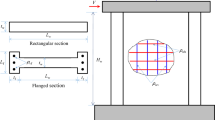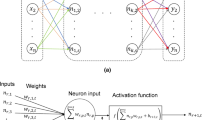Abstract
Staggered rectangular perforations (slots) are provided in the webs of cold-formed steel (CFS) beams and columns to reduce their thermal conductivity and improve the energy efficiency of CFS buildings. The perforations adversely affect the structural characteristics of the members, especially those governed by the web parameters, such as the shear strength and shear buckling. This paper presents machine learning (ML) models to predict the elastic shear buckling load and the ultimate shear strength of CFS channels with slotted webs. Support vector machine (SVM), decision tree (DT), random forest (RF), and k-nearest neighbor (KNN) regressors were trained using a large dataset of numerical results with 3512 samples. An extensive search was conducted to find optimal hyperparameters of the models that result in the best predictions and prevent overfitting. The models’ performances were evaluated employing the ten-fold cross-validation method to make more data available for training and reduce bias and variance. The SVR, DT, and RF models demonstrate good prediction accuracy, which exceeds the accuracy of the existing descriptive equations. Relative feature importance was evaluated using the permutation and SHAP methods for each model. Partial dependence of the buckling load and the shear strength from the channel features was assessed. The predictions of the developed ML models were also compared with the predictions of previously developed artificial neural networks (ANNs). The comparisons demonstrated that ANNs showed higher accuracy in predicting the elastic buckling load, whereas the SVR model provided the most accurate shear strength predictions.














Similar content being viewed by others
Change history
03 November 2023
A Correction to this paper has been published: https://doi.org/10.1007/s44150-023-00105-9
References
Höglund T, Burstrand H (1998) Slotted steel studs to reduce thermal bridges in insulated walls. Thin-Walled Struct 32(1–3):81–109. https://doi.org/10.1016/S0263-8231(98)00028-7
Lipták-Váradi J (2010) Equivalent thermal conductivity of steel girders with slotted web. Periodica Polytechnica Civil Engineering 54(22):163–170. https://doi.org/10.3311/pp.ci.2010-2.12
Kesti J (2000) Local and distortional buckling of perforated steel wall studs. PhD thesis, Helsinki University of Technology
Salhab B, Wang YC (2008) Equivalent thickness of cold-formed thin-walled channel sections with perforated webs under compression. Thin-Walled Struct 46(7):823–838. https://doi.org/10.1016/j.tws.2008.01.029
Kwon YB, Soe EK, Lim DM, Kim GD, Kwon IK (2012) The compressive strength of thin-walled cold-formed steel studs with slits in the web. Journal of Korean Society of Steel Construction 24 (2):189–197. https://doi.org/10.7781/kjoss.2012.24.2.189
Kwon YB, Kim GD, Kwon IK (2014) Compression tests of cold-formed channel sections with perforations in the web. Steel and Composite Structures 16(6):657–679. https://doi.org/10.12989/scs.2014.16.6.657
Naser MZ, Degtyareva NV (2019) Temperature-induced instability in cold-formed steel beams with slotted webs subject to shear. Thin-Walled Struct 136:333–352. https://doi.org/10.1016/j.tws.2018.12.030
Visy D, Szedlák M, Geleji BB, Ádány S (2019) Flexural buckling of thin-walled lipped channel columns with slotted webs: numerical and analytical studies. Eng Struct 197:109399. https://doi.org/10.1016/j.engstruct.2019.109399
Degtyareva N, Gatheeshgar P, Poologanathan K, Gunalan S, Lawson M, Sunday P (2019) Combined bending and shear behaviour of slotted perforated steel channels: numerical studies. J Constr Steel Res 161:369–384. https://doi.org/10.1016/j.jcsr.2019.07.008
Degtyareva N, Gatheeshgar P, Poologanathan K, Gunalan S, Shyha I, McIntosh A (2020) Local buckling strength and design of cold-formed steel beams with slotted perforations. Thin-Walled Struct 156:106951. https://doi.org/10.1016/j.tws.2020.106951
Degtyareva N, Gatheeshgar P, Poologanathan K, Gunalan S, Tsavdaridis KD, Napper S (2020) New distortional buckling design rules for slotted perforated cold-formed steel beams. J Constr Steel Res 168:106006. https://doi.org/10.1016/j.jcsr.2020.106006
Degtyareva NV, Degtyarev VV (2016) Experimental investigation of cold-formed steel channels with slotted webs in shear. Thin-Walled Struct 102:30–42. https://doi.org/10.1016/j.tws.2016.01.012
Degtyareva N, Poologanathan K, Mahendran M (2021) Web crippling tests of cold-formed steel channels with staggered web perforations. Thin-Walled Struct 159:107314. https://doi.org/10.1016/j.tws.2020.107314
Degtyarev VV, Degtyareva NV (2017) Numerical simulations on cold-formed steel channels with flat slotted webs in shear. Part I: elastic shear buckling characteristics. Thin-Walled Struct 119:22–32. https://doi.org/10.1016/j.tws.2017.05.026
Degtyarev VV, Degtyareva NV (2017) Numerical simulations on cold-formed steel channels with flat slotted webs in shear. Part II: ultimate shear strength. Thin-Walled Struct 119:211–223. https://doi.org/10.1016/j.tws.2017.05.028
Degtyarev VV, Degtyareva NV (2018) Numerical simulations on cold-formed steel channels with longitudinally stiffened slotted webs in shear. Thin-Walled Struct 129:429–456. https://doi.org/10.1016/j.tws.2018.05.001
Degtyarev VV, Degtyareva NV (2016) Finite element modeling of cold-formed steel channels with solid and slotted webs in shear. Thin-Walled Struct 103:183–198. https://doi.org/10.1016/j.tws.2016.02.016
Degtyarev V, Degtyareva N (2020) Elastic shear buckling loads and ultimate shear strengths of CFS channels with slotted webs: FE simulation results. Mendeley Data. https://doi.org/10.17632/t9hhkngdwv.1
Jiang F, Jiang Y, Zhi H, Dong Y, Li H, Ma S, Wang Y, Dong Q, Shen H, Wang Y (2017) Artificial intelligence in healthcare: past, present and future. Stroke and Vascular Neurology 2(4). https://doi.org/10.1136/svn-2017-000101
Tadapaneni NR (2019) Artificial intelligence in finance and investments. Int J Innovative Res Sci Eng Technol 9(5):2792–2795
Ma Y, Wang Z, Yang H, Yang L (2020) Artificial intelligence applications in the development of autonomous vehicles: a survey. IEEE/CAA Journal of Automatica Sinica 7(2):315–329. https://doi.org/10.1109/JAS.2020.1003021
Wuest T, Weimer D, Irgens C, Thoben KD (2016) Machine learning in manufacturing: advantages, challenges, and applications. Production & Manufacturing Research 4(1):23–45. https://doi.org/10.1080/21693277.2016.1192517
Kartam N, Flood I, Garrett JH (1997) Artificial neural networks for civil engineers: fundamentals and applications. American Society of Civil Engineers. New York, NY
Adeli H (2001) Neural networks in civil engineering: 1989–2000. Computer-Aided Civil and Infrastructure Engineering 16(2):126–142. https://doi.org/10.1111/0885-9507.00219
Salehi H, Burgueño R (2018) Emerging artificial intelligence methods in structural engineering. Eng Struct 171:170–189. https://doi.org/10.1016/j.engstruct.2018.05.084
Naser MZ (2021) Systematic Integration of Artificial Intelligence Toward Evaluating Response of Materials and Structures in Extreme Conditions. In: Deo R., Samui P., Kisi O., Yaseen Z. (eds) Intelligent Data Analytics for Decision-Support Systems in Hazard Mitigation. Springer Transactions in Civil and Environmental Engineering. Springer, Singapore. https://doi.org/10.1007/978-981-15-5772-9_10
Naser MZ (2021) Mechanistically informed machine learning and artificial intelligence in fire engineering and sciences. Fire Technol. https://doi.org/10.1007/s10694-020-01069-8
Kumar M, Yadav N (2013) Buckling analysis of a beam–column using multilayer perceptron neural network technique. J Frankl Inst 350(10):3188–3204. https://doi.org/10.1016/j.jfranklin.2013.07.016
Abambres M, Rajana K, Tsavdaridis KD, Ribeiro TP (2019) Neural network-based formula for the buckling load prediction of I-section cellular steel beams. Computers 8(1):2–26. https://doi.org/10.3390/computers8010002
Tashakori A, Adeli H (2002) Optimum design of cold-formed steel space structures using neural dynamics model. J Constr Steel Res 58(12):1545–1566. https://doi.org/10.1016/S0143-974X(01)00105-5
Guzelbey IH, Cevik A, Erklig A (2006) Prediction of web crippling strength of cold-formed steel sheetings using neural networks. J Constr Steel Res 62(10):962–973. https://doi.org/10.1016/j.jcsr.2006.01.008
Pala M (2006) A new formulation for distortional buckling stress in cold-formed steel members. J Constr Steel Res 62(7):716–722. https://doi.org/10.1016/j.jcsr.2005.09.011
Pala M, Caglar N (2007) A parametric study for distortional buckling stress on cold-formed steel using a neural network. J Constr Steel Res 63(5):686–691. https://doi.org/10.1016/j.jcsr.2006.07.005
D’Aniello M, Güneyisi EM, Landolfo R, Mermerdaş K (2014) Analytical prediction of available rotation capacity of cold-formed rectangular and square hollow section beams. Thin-Walled Struct 77:141–152. https://doi.org/10.1016/j.tws.2013.09.015
Çevik A, Kurtoğlu AE, Bilgehan M, Gülşan ME, Albegmprli HM (2015) Support vector machines in structural engineering: a review. Journal of Civil Engineering and Management 21(3):261–281. https://doi.org/10.3846/13923730.2015.1005021
Liu C, Liu C, Liu C, Huang X, Miao J, Xu W (2019) Fire damage identification in RC beams based on support vector machines considering vibration test. KSCE J Civ Eng 23(10):4407–4416. https://doi.org/10.1007/s12205-019-2353-7
Solhmirzaei R, Salehi H, Kodur V, Naser M (2020) Machine learning framework for predicting failure mode and shear capacity of ultra high performance concrete beams. Eng Struct 224:111221. https://doi.org/10.1016/j.engstruct.2020.111221
Ahmad MS, Adnan SM, Zaidi S, Bhargava P (2020) A novel support vector regression (SVR) model for the prediction of splice strength of the unconfined beam specimens. Constr Build Mater 248:118475. https://doi.org/10.1016/j.conbuildmat.2020.118475
Nguyen H, Vu T, Vo TP, Thai HT (2021) Efficient machine learning models for prediction of concrete strengths. Constr Build Mater 266:120950. https://doi.org/10.1016/j.conbuildmat.2020.120950
Kang MC, Yoo DY, Gupta R (2021) Machine learning-based prediction for compressive and flexural strengths of steel fiber-reinforced concrete. Constr Build Mater 266:121117. https://doi.org/10.1016/j.conbuildmat.2020.121117
Su M, Zhong Q, Peng H, Li S (2021) Selected machine learning approaches for predicting the interfacial bond strength between FRPs and concrete. Constr Build Mater 270:121456. https://doi.org/10.1016/j.conbuildmat.2020.121456
Mangalathu S, Jang H, Hwang SH, Jeon JS (2020) Data-driven machine-learning-based seismic failure mode identification of reinforced concrete shear walls. Eng Struct 208:110331. https://doi.org/10.1016/j.engstruct.2020.110331
Zhang J, Ma G, Huang Y, Aslani F, Nener B et al (2019) Modelling uniaxial compressive strength of lightweight self-compacting concrete using random forest regression. Constr Build Mater 210:713–719. https://doi.org/10.1016/j.conbuildmat.2019.03.189
Mangalathu S, Hwang SH, Jeon JS (2020) Failure mode and effects analysis of RC members based on machine-learning-based SHapley Additive exPlanations (SHAP) approach. Eng Struct 219:110927. https://doi.org/10.1016/j.engstruct.2020.110927
Olalusi OB, Awoyera PO (2021) Shear capacity prediction of slender reinforced concrete structures with steel fibers using machine learning. Eng Struct 227:111470. https://doi.org/10.1016/j.engstruct.2020.111470
Naser M, Salehi H (2020) Machine learning-driven assessment of fire-induced concrete spalling of columns. ACI Mater J 117(6):7–16. https://doi.org/10.14359/51728120
Lyu ZJ, Zhao P, Lu Q, Xiang Q, Li H (2020) Prediction of the bending strength of boltless steel connections in storage pallet racks: an integrated experimental-FEM-SVM methodology. Advances in Civil Engineering 2020:5109204. https://doi.org/10.1155/2020/5109204
Kim SH, Song X, Cho C, Lee CH (2021) Strength prediction of steel CHS X-joints via leveraging finite element method and machine learning solutions. J Constr Steel Res 176:106394. https://doi.org/10.1016/j.jcsr.2020.106394
Panev Y, Kotsovinos P, Deeny S, Flint G (2021) The use of machine learning for the prediction of fire resistance of composite shallow floor systems. Fire Technol. https://doi.org/10.1007/s10694-021-01108-y
Fu F (2020) Fire induced progressive collapse potential assessment of steel framed buildings using machine learning. J Constr Steel Res 166:105918. https://doi.org/10.1016/j.jcsr.2019.105918
Degtyarev VV (2021) Neural networks for predicting shear strength of CFS channels with slotted webs. J Constr Steel Res 177:106443. https://doi.org/10.1016/j.jcsr.2020.106443
Hastie T, Tibshirani R, Friedman J (2009) The elements of statistical learning: data mining, inference, and prediction. Springer Science & Business Media
Géron A (2019) Hands-on machine learning with Scikit-Learn, Keras, and TensorFlow: concepts, tools, and techniques to build intelligent systems. O’Reilly Media
Vapnik V (1995) The nature of statistical learning theory. Springer, New York
Cortes C, Vapnik V (1995) Support-vector networks. Machine Learning 20(3):273–297
Vapnik V, Golowich SE, Smola A et al (1997) Support vector method for function approximation, regression estimation, and signal processing. Advances in Neural Information Processing Systems, pp 281–287
Smola AJ, Schölkopf B (2004) A tutorial on support vector regression. Statistics and Computing 14(3):199–222
Pedregosa F, Varoquaux G, Gramfort A, Michel V, Thirion B, Grisel O, Blondel M, Prettenhofer P, Weiss R, Dubourg V et al (2011) Scikit-learn: machine learning in python. The Journal of Machine Learning Research 12:2825–2830
Breiman L (2001) Random forests. Machine Learning 45(1):5–32
Ho TK (1995) Random decision forests. In: Proceedings of 3rd international conference on document analysis and recognition, vol 1. IEEE, pp 278–282
Claesen M, Simm J, Popovic D, Moreau Y, De Moor B (2014) Easy hyperparameter search using optunity. arXiv:14121114
Clerc M, Kennedy J (2002) The particle swarm-explosion, stability, and convergence in a multidimensional complex space. IEEE Transactions on Evolutionary Computation 6(1):58–73
Naser M, Alavi A (2020) Insights into performance fitness and error metrics for machine learning. arXiv:200600887
Lundberg S, Lee SI (2017) A unified approach to interpreting model predictions. arXiv:170507874
Author information
Authors and Affiliations
Corresponding author
Additional information
Publisher’s Note
Springer Nature remains neutral with regard to jurisdictional claims in published maps and institutional affiliations.
Rights and permissions
Springer Nature or its licensor (e.g. a society or other partner) holds exclusive rights to this article under a publishing agreement with the author(s) or other rightsholder(s); author self-archiving of the accepted manuscript version of this article is solely governed by the terms of such publishing agreement and applicable law.
About this article
Cite this article
Degtyarev, V.V. Predicting shear strength of CFS channels with slotted webs by machine learning models. Archit. Struct. Constr. 1, 3–20 (2021). https://doi.org/10.1007/s44150-021-00001-0
Received:
Accepted:
Published:
Issue Date:
DOI: https://doi.org/10.1007/s44150-021-00001-0




